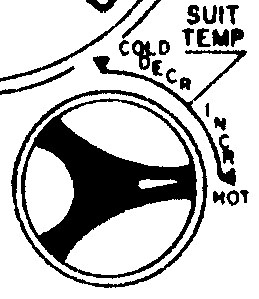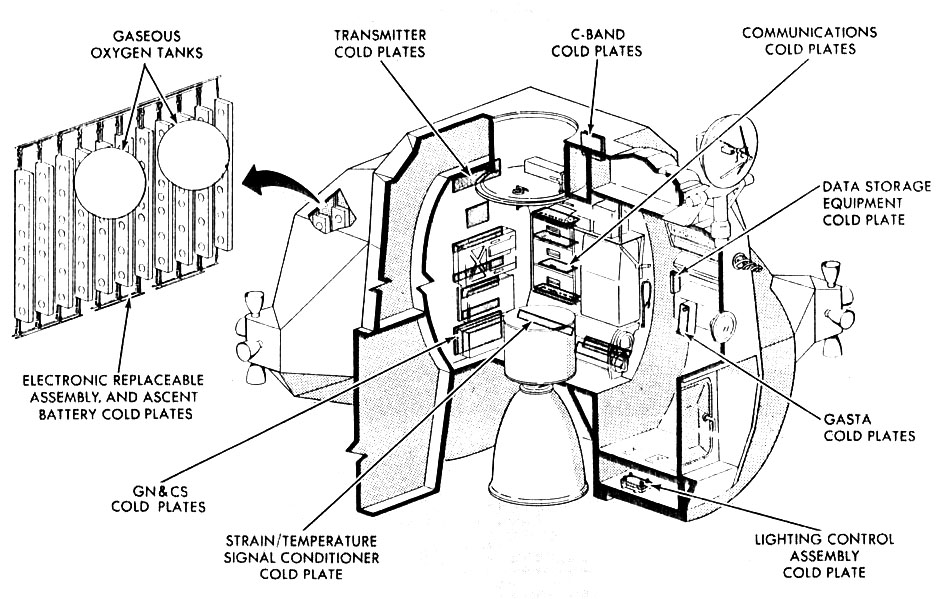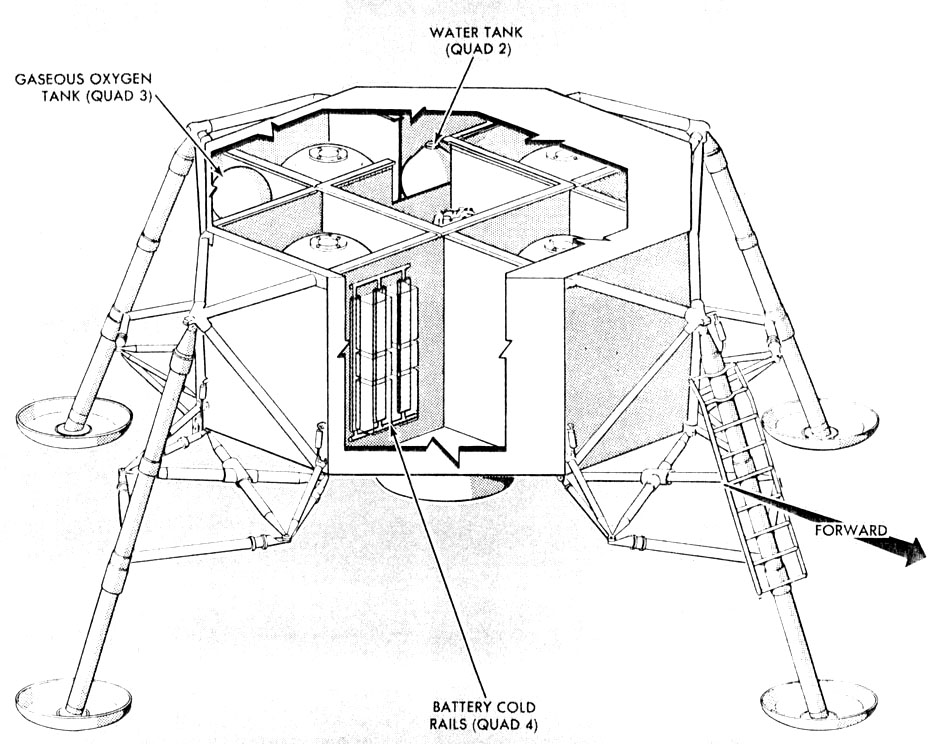
ECS Equipment - Heat Transport Section
COOLANT ACCUMULATOR
There are two accumulators, one in the primary loop and an identical one in the secondary loop, The coolant accumulator consists of a two-piece aluminum cylinder that contains a movable springloaded piston bonded to a diaphragm. The fluid side contains approximately 46 cubic inches of fluid under pressure. The pressure varies, directly with fluid level, from 5.6 psia at 5% level to 8.0 psia at 80% level. The accumulator maintains a head of pressure on the glycol pump inlets to prevent pump cavitation and replaces coolant lost through subsystem leakage. The piston moves in response to volumetric changes caused by temperature variations in the primary loop or by leakage. The accumulator spring side is vented to space.
The accumulator has a low-level sensor with a switch that trips when only 10 ± 5% of the coolant volume remains. The switch is mounted on top of the accumulator. A tube extending from the top of the accumulator, houses a rod attached to the piston. The switch provides a telemetry signal.
PRIMARY COOLANT FILTER
The primary coolant filter has a filtering capability of 35 microns. It has an integral pressure relief bypass feature that opens at 0.27 to 0.4 psid to maintain coolant flow to the pumps if the filter becomes clogged.
COOLANT PUMP
The three coolant pumps are identical. Two pumps are connected in the primary loop; the third pump, in the secondary loop. The pumps are of the sliding-vane, positive-displacement type; they are driven by 28-volt d-c brushless motors. The motors are of wet or submerged design and are cooled by the recirculating coolant. The pump speeds will vary with changes in coolant temperatures and pump input voltages. As a result, system coolant flow rates may vary from 4.2 to 5.4 pounds per hour causing primary pump pressure rise of 12 to 25 psi and secondary pump pressure rise of 8 to 18 psi.
SUIT TEMPERATURE CONTROL VALVE
The suit temperature control valve is a manually operated diverter valve. The amount of warm coolant flowing through the suit circuit regenerative heat exchanger is regulated by the handle, which can be turned from hot to cold.

Suit Temperature Control Valve
SUBLIMATORS
The porous-plate-type sublimators (one in the primary loop and another in the secondary loop) are identical, except that the primary sublimator has a larger capacity. Each sublimator has a coolant inlet and outlet, a water inlet, and a steam outlet. Water makes one pass through the unit; coolant makes six passes through the primary sublimator and four passes through the secondary sublimator. For proper sublimator operation, water pressure must exceed 4.0 psia, but be less than 6.5 psia. The water pressure must also be less than the suit circuit static pressure plus the head pressure from the water separators to the sublimator.
The unit rejects heat to space by sublimation of ice. Water from the WMS flows through the water passages, into the porous plates, and is exposed to space environment. The vacuum pressure is below the triple point of water; this causes an ice layer to develop within the pores and on the inner surface of the plates. As the hot coolant flows through the sublimator passages, heat transfers from the coolant to the water and to the ice layer. The ice sublimates from the solid state to steam without passing through a liquid state, rejecting its heat load overboard through a duct. The thickness of the ice layer varies with the heat load imposed on the sublimator, resulting in a regulated output temperature over a range of input temperatures.
COLD PLATES AND RAILS
Electronic equipment that requires active temperature control is cooled by cold plates and cold rails. Most flat cold plates are installed between electronic equipment and the LM structure in a manner that minimizes heat transfer from the structure to the coolant, to avoid a reduction of the coolant cooling capacity. The surrounding structure and equipment may have a temperature range of 0 F to +160 F. The remaining flat cold plates are installed directly on the electronic equipment without making contact with the LM structure. Cold rails are also structural members and are used in the aft equipment bay in the descent stage for the DSEA. The IMU has an integral cooling circuit. Cold plates and cold rails for equipment essential for mission abort have two independent coolant passages, one for the primary loop and one for the secondary loop.

Ascent Stage Components
The flat cold plates are brazed assemblies with inlet and outlet fittings. The coolant flows between two parallel sheets, which are connected by fins for increased heat transfer and structural strength. The internal fin arrangement of these cold plates ensures sufficient flow distribution.

Descent Stage Components
The cold rails are channel-and-tube-type extrusions; the tubular part forms the inside center of the channel. The tube has fins and, at the ends, coolant inlet and outlet fittings. The cold rails are installed in parallel arrangement, with equal space between the rails to accommodate equipment designed for mounting on cold rails. Each cold rail (except the first and the last one) cools two adjacent rows of equipment.
Return to LM ECS




